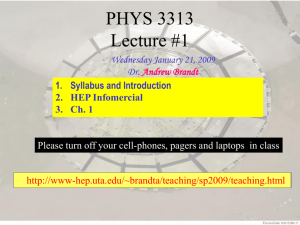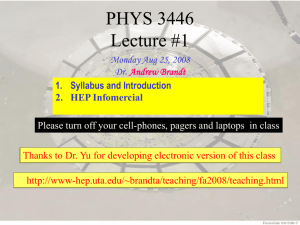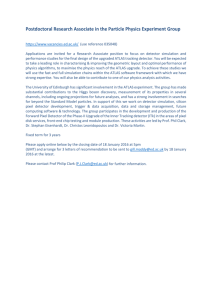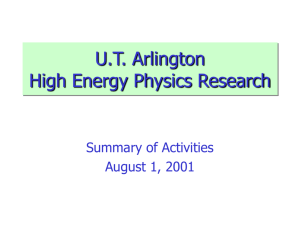phys3446-lec1
advertisement
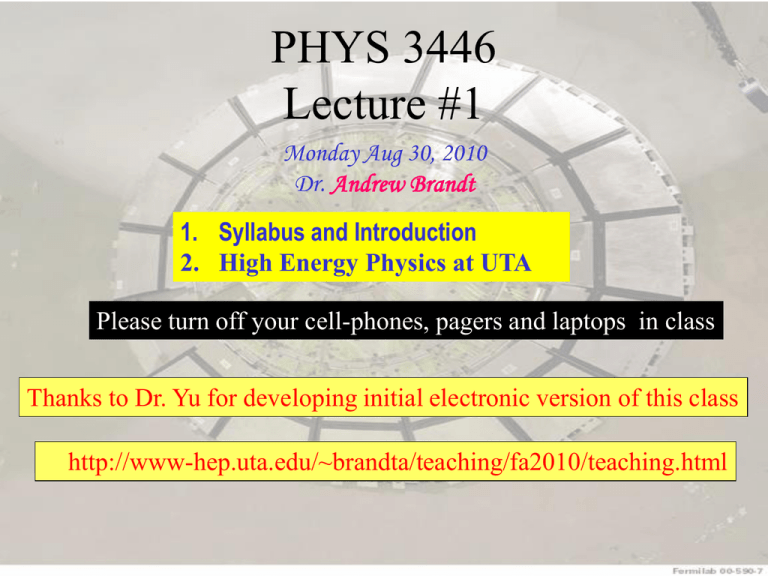
PHYS 3446 Lecture #1 Monday Aug 30, 2010 Dr. Andrew Brandt 1. Syllabus and Introduction 2. High Energy Physics at UTA Please turn off your cell-phones, pagers and laptops in class Thanks to Dr. Yu for developing initial electronic version of this class http://www-hep.uta.edu/~brandta/teaching/fa2010/teaching.html My Background+Research B.S. Physics and Economics College of William&Mary 1985 PH.D. UCLA/CERN High Energy Physics 1992 (UA8 Experiment-discovered hard diffraction) 1992-1999 Post-doc and Wilson Fellow at Fermilab -Discovered hard color singlet exchange -1997 PECASE Award for contributions to diffraction -Proposed and built (with collaborators from Brazil) DØ Forward Proton Detector -QCD Physics Convenor -Trigger Meister 1999-2004 UTA Assistant Prof .; 2004-2010 Assoc. Prof.; Today- Professor - DOE OJI, NSF MRI, Texas ARP awards for DØ FPD -2005 started fast timing work (ARP, DOE ADR) -2007 Grant on WMD detection using nanoparticles w/Dr. Chen -2008 sabbatical on ATLAS Grading • Only test is a Midterm: 25% – No Final – Test will be curved if necessary – No makeup tests • Homework: 20% (no late homework) • Lab score: 25% (details soon) • Project: 20% (a look at early ATLAS data or a report/presentation on important events in particle physics?) • Pop Quizzes: 10% Attendance and Class Style • Attendance: – is STRONGLY encouraged, to aid your motivation I give pop quizzes • Class style: – Lectures will be primarily on electronic media • The lecture notes will be posted AFTER each class – Will be mixed with traditional methods (blackboard) – Active participation through questions and discussion are STRONGLY encouraged Physics History • Classical Physics: forces, motion, work, energy, E&M, (Galileo, Newton, Faraday, Maxwell) • In modern physics (Einstein, Planck, Bohr) we covered relativity, models for the atom, some statistical mechanics, and finished with a bit of discussion about the nucleus and binding energy circa 1930 when the neutron was discovered • What’s new since 1930? Physics History • I’m going to have to respectfully disagree with you Leonard… • 1937 muon discovered (who ordered that?) • With advent of particle accelerators came particle zoo • There was a need to classify all the new particles being discovered and try to understand the underlying forces and theory Course Material • Nuclear Physics – Models of atom – Cross sections – Radiation • High Energy Experiment – Energy deposition in matter – Particle detector techniques – Accelerators • HEP Phenomenology – – – – Elementary particle interactions Symmetries The Standard Model Beyond the Standard Model High Energy Physics at UTA UTA faculty Andrew Brandt, Kaushik De, Amir Farbin, Andrew White, Jae Yu along with many post-docs, graduate and undergraduate students investigate the basic forces of nature through particle physics studies at the world’s highest energy accelerators In the background is a photo of a sub-detector of the 5000 ton DØ detector. This sub-detector was designed and built at UTA and is currently operating at Fermi National Accelerator Laboratory near Chicago. Structure of Matter Matter Molecule Atom Nucleus Baryon Quark (Hadron) u cm 10-14m 10-9m 10-10m Nano-Science/Chemistry Atomic Physics Nuclear Physics 10-15m <10-19m top protons, neutrons, , bottom, mesons, etc. charm, strange, p,W,L... up, down Electron (Lepton) <10-18m High energy means small distances High Energy Physics Helium Periodic Table Neon All atoms are made of protons, neutrons and electrons u u d u d d Neutron Proton Gluons hold quarks together Photons hold atoms together Electron What is High Energy Physics? Matter/Forces at the most fundamental level. Great progress! The “STANDARD MODEL” BUT… many mysteries => Why so many quarks/leptons?? => Why four forces?? Unification? => Where does mass come from?? => Are there higher symmetries?? What is the “dark matter”?? Will the LHC create a black hole that destroys the Earth? NO! See: http://public.web.cern.ch/Public/en/LHC/Safety-en.html Role of Particle Accelerators • Smash particles together • Act as microscopes and time machines – The higher the energy, the smaller object to be seen – Particles that only existed at a time just after the Big Bang can be made • Two method of accelerator based experiments: – Collider Experiments: p`p, pp, e+e-, ep – Fixed Target Experiments: Particles on a target – Type of accelerator depends on research goals Fermilab Tevatron and CERN LHC • Currently Highest Energy proton-anti-proton collider – Ecm=1.96 TeV (=6.3x10-7J/p 13M Joules on 10-4m2) Equivalent to the K.E. of a 20 ton truck at a speed 81 mi/hr Highest Energy (proton-proton) collider since fall 2009 – Ecm=14 TeV (=44x10-7J/p 1000M Joules on 10-4m2) Equivalent to the K.E. of a 20 ton truck at a speed 711 mi/hr Currently 7 TeV collisions Chicago 1500 physicists 130 institutions 30 countries CDF • p Tevatron DØ `p Fermilab: http://www.fnal.gov/ ; DØ: http://www-d0.fnal.gov/ 5000 physicists 250 institutions 60 countries CERN: http://www.cern.ch/ ; ATLAS: http://atlas.web.cern.ch/ The International Linear Collider European Design 500 GeV (800 GeV) • Long~ linear electron-position colliders 33km= • Optimistically 15 years from now 21mi • Takes 10 years to 47 km build an accelerator =29 mi and the detectors Dr.White is cospokesman of SiD detector US Design 500 GeV (1 TeV) Particle Identification Energy Scintillating Fiber Silicon Tracking Calorimeter (dense) Interaction Point Ä B EM Muon Tracks Magnet Charged Particle Tracks hadronic electron photon Wire Chambers jet neutrino (or any noninteracting particle missing transverse momentum) We know x,y starting momenta is zero, but along the z axis it is not, so many of our measurements are in the xy plane, or transverse muon DØ Detector ATLAS Detector 30’ 50’ • • • • • • Weighs 5000 tons As tall as a 5 story building Can inspect 3,000,000 collisions/second Record 100 collisions/second Records 10 Mega-bytes/second Recording 0.5x1015 (500,000,000,000,000) bytes per year (0.5 PetaBytes). • • • • • • Weighs 10,000 tons As tall as a 10 story building Can inspect 1,000,000,000 collisions/second Recors 200 -300 collisions/second Records 300 Mega-bytes/second Will record 2.0x1015 (2,000,000,000,000,000) bytes each year (2 PetaByte). The Standard Model Standard Model has been very successful but has too many parameters, does not explain origin of mass. Continue to probe and attempt to extend model. The strong force is different from E+M and gravity! new property, color charge confinement - not usual 1/r2 • Current list of elementary (i.e. indivisible) particles • Antiparticles have opposite charge, same mass UTA and Particle Physics Fermilab/Chicago CERN/Geneva Building Detectors at UTA High Energy Physics Training + Jobs EXPERIENCE: 1) Problem solving 2) Data analysis 3) Detector construction 4) State-of-the-art high speed electronics 5) Computing (C++, Python, Linux, etc.) 6) Presentation 7) Travel JOBS: 1) Post-docs/faculty positions 2) High-tech industry 3) Computer programming and development 4) Financial My Main Research Interests • Physics with Forward Proton Detectors • Fast timing detectors • Triggering (selecting the events to write to tape): at ATLAS must choose most interesting 300 out of up to 40,000,000 events/sec DØ Forward Proton Detector (FPD) - a series of momentum spectrometers that make use of accelerator magnets in conjunction with position detectors along the beam line to measure the momentum and scattering angle of the proton • Dipole Spectrometer • inside the beam ring in the horizontal plane • use dipole magnet (bends beam) • Quadrupole Spectrometers • surround the beam: up, down, in, out • use quadrupole magnets (focus beam) • also shown here: separators (bring beams together for collisions) A total of 9 spectrometers comprised of 18 Roman Pots Data taking finished, analysis in progress (Mike Strang Ph.D. 2006) Detector Construction At the University of Texas, Arlington (UTA), scintillating and optical fibers were spliced and inserted into the detector frames. The cartridge bottom containing the detector is installed in the Roman pot and then the cartridge top with PMT’s is attached. Tevatron: World’s 2nd Highest Energy Collider Fermilab DØ High-tech fan One of the DØ Forward Proton Detectors built at UTA and installed in the Tevatron tunnel Elastic Scattering Cross Section (FPD) Single Diffractive Cross Section (FPD) Arnab Pal (UTA PhD student) ATLAS Forward Protons: A (10) Picosecond Window on the Higgs Boson Andrew Brandt, University of Texas at Arlington A picosecond is a trillionth of a second. This door opens ~once a second, if it opened every 10 picoseconds it would open a hundred billion times in one second (100,000,000) Light can travel 7 times around the earth in one second but can only travel 3 mm in 10 psec Yes, I know it’s a door, not a window! January 12, 2010 Andrew Brandt SLAC Seminar 27 Central Exclusive Higgs AFP concept: adds new ATLAS sub-detectors at 220 and 420 m upstream and downstream of central detector to precisely measure the scattered protons to complement ATLAS discovery program. These detectors are designed to run at a luminosity of 1034 cm-2s-1 and operate with standard optics (need high luminosity for discovery physics) beam 420 m LHC magnets p’ AFP Detector 220 m H p’ You might ask: “Why build a 14 TeV collider and have 99% of your energy taken away by the protons, are you guys crazy or what??” The answer is “or what”!—ATLAS is routinely losing energy down the beam pipe, we just measure it accurately!!! Note: the quest for optimal S/B Ex. The leading discovery channel for light 28 SM can take you to interesting places: Higgs, H , has a branching ratio of 0.002! Cerenkov Effect n=1 n>>1 particle Use this property of prompt radiation to develop a fast timing counter Micro-Channel Plate Photomultiplier Tube (MCP-PMT) e - + + photon Faceplate Photocathode Photoelectron Dual MCP DV ~ 200V DV ~ 2000V Gain ~ 106 MCP-PMT DV ~ 200V Anode Ultra-fast Timing Issues Time resolution for the full detector system: 1. Intrinsec detector time resolution 2. Jitter in PMT's 3. Electronics (AMP/CFD/TDC) 4. Reference Timing • • • • • 3 mm =10 ps Radiation hardness of all components of system Lifetime and recovery time of tube Backgrounds Multiple proton timing January 12, 2010 Andrew Brandt SLAC Seminar 31 Laser Tests Study properties of MCP-PMT’s: 1) How does timing depend on gain and number of pe’s 2) What is maximum rate? How does this depend on various quantities? 3) Establish minimum gain to achieve timing goals of our detector given expected number of pe’s (~10). Evaluate different electronics choices at the working point of our detector 4) Eventually lifetime tests ***Ongoing laser tests very useful in developing the fastest time of flight detector ever deployed in a collider experiment 32 PTF LeCroy Wavemaster 6 GHz Oscilloscope Hamamatsu PLP-10 Laser Power Supply Picosecond Test Facility featuring initial Undergraduate Laser Gang (UGLG) Undergraduate Laser Youths? (UGLY) Laser Box mirror beam splitter MCP-PMT filter lenses January 12, 2010 Andrew Brandt SLAC Seminar laser 33 Timing vs Gain for 10 m Tube Measured with reference tube using CFD’s and x100 mini-circuits amps, with 10 pe’s can operate at ~5E4 Gain (critical for reducing rate and lifetime issues) With further optimization have obtained <25 ps resolution for 10 pe’s. 34 Timing vs. Number of PE’s 45 40 Time Resolution (ps) 35 30 HV 2350 25 HV 2450 20 HV 2650 HV 2750 15 HV 2850 10 5 0 0 20 40 60 80 100 120 #PE No dependence of timing on gain if sufficient amplification! 35 Aside: Measuring Speed of EM Waves • We noted that ground plane oscillations on reference tube were picked up by second tube • Used this to do a 3% measurement of speed of light (Kelly Kjornes) Moving 2nd tube 2 feet from reference tube shifts pick-up oscillation pattern by 2.05 ns 36 New Multi-Channel Laser Setup January 12, 2010 Andrew Brandt SLAC Seminar 37 Pre-lecture Conclusions • Nuclear and Particle picks up where Modern Physics left off • One of the current frontiers of physics is high energy or particle physics: very interesting (I think!) • Nobel Prize possibilities • Other interesting areas of physics at UTA include nano-bio physics, astrophysics, nano-magnetism, etc. Summary • If you are here to learn about Nuclear/Particle Physics this should be an interesting and fun class, if you are here because you need four hours of physics…. a) get out while you still can OR b) it will still be an interesting and fun class (up to you) • It is an opportunity to learn about high energy physics from a high energy physicist • Lab takes time, there will be reading outside of main text • See me if interested in UG research project in particle physics
